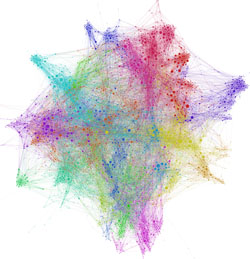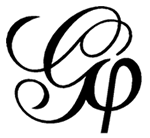 The new version of the build-in layout ForceAtlas is now released. It is scaled for small to medium-size graphs, and is adapted to qualitative interpretation of graphs. The equations are the same as ForceAtlas 1, but there are more options and innovative optimizations that make it a very fast layout algorithm.
The new version of the build-in layout ForceAtlas is now released. It is scaled for small to medium-size graphs, and is adapted to qualitative interpretation of graphs. The equations are the same as ForceAtlas 1, but there are more options and innovative optimizations that make it a very fast layout algorithm.
It is good enough to deal with very small graphs (10 nodes) and fast enough to spatialize 10,000 nodes graphs in few minutes, with the same quality. If you have time, it can deal with even bigger graphs.
 Update Gephi (Help > Check for Updates) to get this new layout.
Update Gephi (Help > Check for Updates) to get this new layout.
Force Atlas 2:
- Is a continuous algorithm, that allows you to manipulate the graph while it is rendering (a classic force-vector, like Fruchterman Rheingold, and unlike OpenOrd)
- Has a linear-linear model (attraction and repulsion proportional to distance between nodes). The shape of the graph is between Früchterman & Rheingold’s layout and Noack’s LinLog.
- Features a unique adaptive convergence speed that allows most graphs to converge more efficiently
- Proposes summarized settings, focused on what impact the shape of the graph (scaling, gravity…). Default speed should be the good one.
- Now features a Barnes Hut optimization (performance drops less with big graphs)
Force Atlas 2 features these settings:
- Scaling: How much repulsion you want. More makes a more sparse graph.
- Gravity: Attracts nodes to the center. Prevents islands from drifting away.
- Dissuade Hubs: Distributes attraction along outbound edges. Hubs attract less and thus are pushed to the borders.
- LinLog mode: Switch ForceAtlas’ model from lin-lin to lin-log (tribute to Andreas Noack). Makes clusters more tight.
- Prevent Overlap: Use only when spatialized. Should not be used with “Approximate Repulsion”
- Tolerance (speed): How much swinging you allow. Above 1 discouraged. Lower gives less speed and more precision.
- Approximate Repulsion: Barnes Hut optimization: n² complexity to n.ln(n) ; allows larger graphs.
- Approximation: Theta of the Barnes Hut optimization.
- Edge Weight Influence: How much influence you give to the edges weight. 0 is “no influence” and 1 is “normal”.
Force Atlas 2 was created by Mathieu Jacomy at the Sciences Po Médialab (Paris), founding member of the Gephi Consortium.
 Tutorial: Download it in PDF.
Tutorial: Download it in PDF.

 Update Gephi (Help > Check for Updates) to get this new layout.
Update Gephi (Help > Check for Updates) to get this new layout.